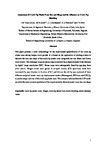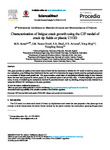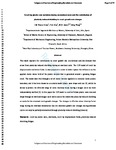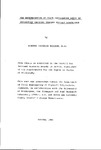Assessment of crack tip plastic zone size and shape and its influence on crack tip shielding
| dc.contributor.author | Vasco-Olmo, JM | |
| dc.contributor.author | James, Neil | |
| dc.contributor.author | Christopher, Colin | |
| dc.contributor.author | Patterson, EA | |
| dc.contributor.author | Díaz, FA | |
| dc.date.accessioned | 2016-07-28T15:13:59Z | |
| dc.date.available | 2016-07-28T15:13:59Z | |
| dc.date.issued | 2016-08-01 | |
| dc.identifier.issn | 8756-758X | |
| dc.identifier.issn | 1460-2695 | |
| dc.identifier.uri | http://hdl.handle.net/10026.1/5131 | |
| dc.description.abstract |
<jats:title>Abstract</jats:title><jats:p>This paper presents a novel methodology for the experimental quantification of the crack tip plastic zone during fatigue crack growth. It is based on the application of yielding criteria to estimate the area and shape of the crack tip plastic zone using both the von Mises and Tresca yield criteria. The technique employs strain maps calculated from displacement fields obtained by digital image correlation. Stress maps were subsequently found by applying these yield criteria. Fatigue cracks were grown in compact tension specimens made from commercially pure titanium at <jats:italic>R</jats:italic> ratios of 0.1 and 0.6, and the ability was explored of three different analytical elastic crack tip displacement models [Westergaard, Williams and Christopher–James–Patterson (CJP)], to predict shape and size of the crack tip plastic zone. This analysis indicated that the CJP model provided the most accurate prediction of the experimentally obtained plastic zone size and shape.</jats:p> | |
| dc.format.extent | 969-981 | |
| dc.language | en | |
| dc.language.iso | en | |
| dc.publisher | Wiley | |
| dc.subject | crack shielding | |
| dc.subject | crack tip plastic zone | |
| dc.subject | crack tip stress field | |
| dc.subject | fatigue | |
| dc.subject | stress intensity factor | |
| dc.title | Assessment of crack tip plastic zone size and shape and its influence on crack tip shielding | |
| dc.type | journal-article | |
| dc.type | Journal Article | |
| plymouth.author-url | https://www.webofscience.com/api/gateway?GWVersion=2&SrcApp=PARTNER_APP&SrcAuth=LinksAMR&KeyUT=WOS:000379920800006&DestLinkType=FullRecord&DestApp=ALL_WOS&UsrCustomerID=11bb513d99f797142bcfeffcc58ea008 | |
| plymouth.issue | 8 | |
| plymouth.volume | 39 | |
| plymouth.publication-status | Published | |
| plymouth.journal | Fatigue & Fracture of Engineering Materials & Structures | |
| dc.identifier.doi | 10.1111/ffe.12436 | |
| plymouth.organisational-group | /Plymouth | |
| plymouth.organisational-group | /Plymouth/Faculty of Science and Engineering | |
| plymouth.organisational-group | /Plymouth/Faculty of Science and Engineering/School of Engineering, Computing and Mathematics | |
| plymouth.organisational-group | /Plymouth/REF 2021 Researchers by UoA | |
| plymouth.organisational-group | /Plymouth/REF 2021 Researchers by UoA/EXTENDED UoA 10 - Mathematical Sciences | |
| plymouth.organisational-group | /Plymouth/REF 2021 Researchers by UoA/UoA10 Mathematical Sciences | |
| plymouth.organisational-group | /Plymouth/Users by role | |
| plymouth.organisational-group | /Plymouth/Users by role/Academics | |
| dcterms.dateAccepted | 2016-02-17 | |
| dc.rights.embargodate | 2017-7-13 | |
| dc.identifier.eissn | 1460-2695 | |
| dc.rights.embargoperiod | 12 months | |
| rioxxterms.versionofrecord | 10.1111/ffe.12436 | |
| rioxxterms.licenseref.uri | http://www.rioxx.net/licenses/under-embargo-all-rights-reserved | |
| rioxxterms.licenseref.startdate | 2016-08-01 | |
| rioxxterms.type | Journal Article/Review |





